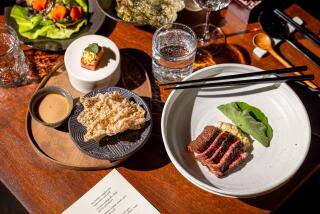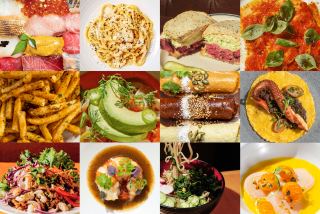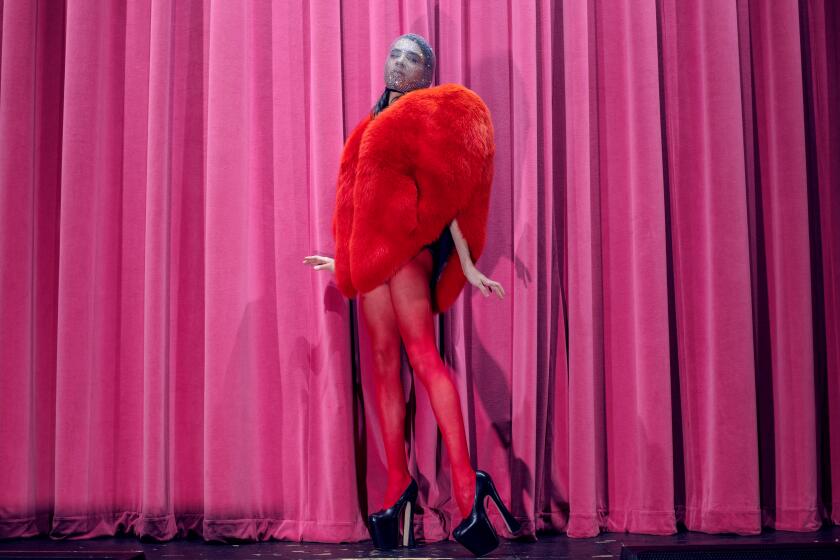Restaurant critics are blowing their own covers
RESTAURANT criticism can be divided into two eras: BG and AG.
Before Google, reviewers could pretty much move freely about their business. Some might have felt compelled to slap on a wig, and those with integrity would definitely reserve and pay under an assumed name, but the game of tabletop charades was on. By all standards of old-media journalism, restaurateurs were not supposed to know when a reviewer with the clout to make or break his investment was anywhere near the kitchen.
After Google, the rules are being rewritten by the hour. When any human being is searchable online not just verbally but visually, how can a critic possibly hope to retain anonymity long enough to give a restaurant a fair evaluation? Throw blogs into the mix and it’s a mashup of Facebook and a masquerade ball.
In the last month, a youngish but old-style critic adamant about his anonymity has been involuntarily outed for all of cyberspace and thousands of magazine readers to see, while a blogger-turned-critic happy to bask in the limelight has been hired by a newspaper that puts her pulchritude on prominent display with every review.
And those developments point up only a few of the ways the onset of AG and the age of transparency has changed what it means to be a restaurant critic. Amateur reviewers are increasingly being taken more seriously. Professionals are blogging. The “ethically limber,” as gawker.com put it, are being exposed by the hordes of people commenting anonymously on blogs and websites who will call a freeloader a freeloader and know where the checks are buried. And smart restaurateurs are Googling themselves to monitor the whole freewheeling dialogue.
High visibility for bloggers has publishers taking notice. Adam Roberts, for instance, parlayed his amateurgourmet.com into a book of the same name, sans the dot-com but subtitled “How to Shop, Chop, and Table Hop Like a Pro (Almost).” His face is now becoming almost as ubiquitous online as those Japanese toilet ads. But after taking all of two free meals, he has decided to lay off most reviewing because, he says, “(a) I’ve started to see the error of my ways; (b) I don’t want to be a restaurant critic.”
“I’d rather make videos with Barbie dolls . . . than be the next Frank Bruni,” he added.
When newspapers had a monopoly, the rules were clear, as they still are at many of the major dailies. The Los Angeles Times requires the restaurant critic to work anonymously, arrive unannounced, make at least three visits and of course always pay for meals. The New York Times and the Philadelphia Inquirer have similar policies. These are also guidelines used by the Assn. of Food Journalists.
These days anyone with a finger to type with can set up shop on the Internet for free and blog through services such as Wordpress and Typepad. In a MySpace world, the faces of the new breed of critic are, of course, often prominent on their blogs. Publicity agents eager for exposure will take coverage they might not get at the big publications, even if it means shelling out for free meals.
And the diner is left to sort it out with Google, or through links on the proliferating aggregate blogs such as eater.com and eaterla.com, which follow the restaurant world like stalkers. (Discussion boards such as chowhound.com and yelp.com are a whole other story.) The result is that choosing a restaurant without seeing what’s been widely written about it is a gamble like never before. Do you trust the old-line critics, the blogger or the commenters?
The critic’s choiceALL this only amplifies the debate, especially online, about the old ways of working. Does being identified really affect a critic’s experience? (Restaurants can change the service and the ingredients, but can a bad kitchen ever turn out great meals on demand?) Is the traditional rule of reviewing anonymously really just a game (or only a performance of kabuki)? And why not just come clean in a world that seems to have become one big virtual confessional?
Danyelle Freeman, a sometime actress and television writer in Los Angeles who started the blog restaurantgirl.com in New York a year and a half ago, takes that last attitude big time. She was hired as a critic by the New York Daily News last month after the New York Times included her in a style story on the increasing effect of restaurant bloggers, and she is riding her new job to a level of billboard exposure. Her first review was accompanied by a half-page profile including a huge photo; her face has been overlaid on every review since. A head shot from her acting days has also been plastered on countless computer screens thanks to eater.com, gawker.com and others.
By contrast, Craig LaBan, who has been restaurant reviewer for the Philadelphia Inquirer for nearly 10 years, has always worked the traditional way, but last month Philadelphia magazine proudly published his photograph with an article about a lawsuit a restaurateur had filed over one of his reviews. In the age of instant communication, the image went viral, with links on food gossip sites even in New York.
Despite their different approaches, Freeman and LaBan both say restaurants really cannot do much to instantly improve when a critic is spotted at table eight. Both said they had suffered either “crummy service” or “chicken not cooked to order” even after being recognized.
“Niceness you can fake,” LaBan said. “Attention you can fake. Skill you can’t.” And as Freeman put it, “They’re not bringing in a new chef, or running out to the green market. The service might be a little swifter, or more polite, but that’s transparent.”
Gael Greene, the legendary New York magazine restaurant critic known for her hats, has gone on review expeditions with Freeman but says she is confident neither was noticed; she always reserves in another name. But she has escalated the anonymity debate on her website-cum-blog, insatiable-critic.com, having put in more years reviewing than the 33 Freeman has been alive. Mouths that roar tend to be inundated with freebie extras, she notes. She always pays for meals, she says.
LaBan contends that even if absolute anonymity is impossible, it is a goal. He said pictures of him had been circulating among restaurateurs almost since he arrived in Philadelphia after a stint at the New Orleans Times-Picayune. “If you’re a critic at a major newspaper in a cosmopolitan city, people make it their business to know who you are,” he said. “It’s more important to arrive unannounced and be discreet. It’s much more important to be a good reporter, be a good eater, be a good critic and be a good writer” than to merely be unknown.
Freeman, however, insists that “anonymity is dated.” “People are really naive to think -- most notable critics -- to think they’re anonymous,” she added.
Google her image and her acting head shot pops up. Do a Google Images search on Frank Bruni of the New York Times and his face is the first image that appears. Meanwhile, finding Michael Bauer of the San Francisco Chronicle or S. Irene Virbila of the Los Angeles Times would take some serious gumshoeing, if you could find them at all. LaBan, who is also relatively obscure in a Google search, notes that so many images are lassoed in those kinds of searches that you have to know for whom you are looking.
Does it matter?BUT Jonathan Gold, who reviews restaurants for the LA Weekly, found himself a public figure after winning the Pulitzer Prize for criticism this year; his face was everywhere, including in the New York Times. Of the many Jonathan Golds who materialize in a Google image search, the winner is easily spotted now. Yet he says he has “noticed absolutely no difference in being recognized in restaurants. None. Zero.”
Gold contends that all prominent reviewers are known to restaurateurs, especially at the high end. Possibly only Michelin reviewers are completely anonymous, he says.
As for tracking what bloggers have to say, Gold admits to reading them “more than is healthy,” often for tips on particular cuisines and neighborhoods. “The blogs that obsess on sake or doughnuts or tacos or Singaporean street food or Pinkberry are great, and I am constantly amazed by the food blogs from Mumbai or Bangkok or Phnom Penh or Saigon that put ‘exotic’ cuisines into real-life context.”
Among Los Angeles restaurant bloggers who offer reviews in one form or another, the Gael Greene dodginess is often the model, with faces relatively obscured, as at Pat Saperstein’s eatingla.com or thedeliciouslife.blogspot.com, run by Sarah J. Gim. Saperstein also includes a statement up high on her ethics, noting that she “tries to pay for as many of [her] meals as possible” but writes “informational articles” rather than reviews of those she is comped. (la.foodblogging.com has a good blog roll of other local voices.)
Eric Greenspan, chef-owner of the Foundry on Melrose, says the bloggers who can be taken seriously are “those that at least do a responsible job of saying who they are” so that readers can “tune in to a voice they can trust,” as opposed to anonymous contributors on discussion boards who may or may not have an agenda.
Greenspan, who said he always knows when a print reviewer is in his restaurant, said he has recognized only one blogger, and only because he went to summer camp with her. But he notes that bloggers often give themselves away by whipping out their digital cameras. And he said he would tell a blogger looking for a free meal that “we don’t pay for reviews, and it’s a shame you’re offering them for sale.”
Even the most recognizable of restaurant critics has good reason to feel rejuvenated lately. So many blogs and websites link to print that even obscure publications now get huge exposure as the critiques are obsessively critiqued. No one has to run out and buy six newspapers on a Wednesday; a site like eater.com will round up every scrap of food news you can use. And the ever-expanding blog rolls mean even the most obscure commentary is never lost in cyberspace.
The new openness is epitomized by Freeman, who believes that “a younger dining set” is looking for “a voice and face to identify with.” Freeman continues to blog on her website. She says her new employers were drawn to her following at the blog, where her face has always been visible, but she adds, “I honestly really don’t know the statistics” on how much traffic it generates. (She estimates 30,000 readers a month, but websites have different ways of counting.)
LaBan, for his part, says that even now that he has been sort of formally exposed, “I’m never going to stick my picture on my column, never going to go up to the maitre d’s stand and say, ‘Guess who’s here.’ I just wouldn’t make it easy for people.”
As for the damage the magazine piece has done, he sounds unperturbed. It’s an old photo, he says, “and I’ve been working on my physique.” Judging by the YouTube video of him singing a love song to the cheeseburger that was unearthed by a person commenting on the Philadelphia magazine website and of course turns up on Google Images, he has indeed.
More to Read
Sign up for our L.A. Times Plants newsletter
At the start of each month, get a roundup of upcoming plant-related activities and events in Southern California, along with links to tips and articles you may have missed.
You may occasionally receive promotional content from the Los Angeles Times.






